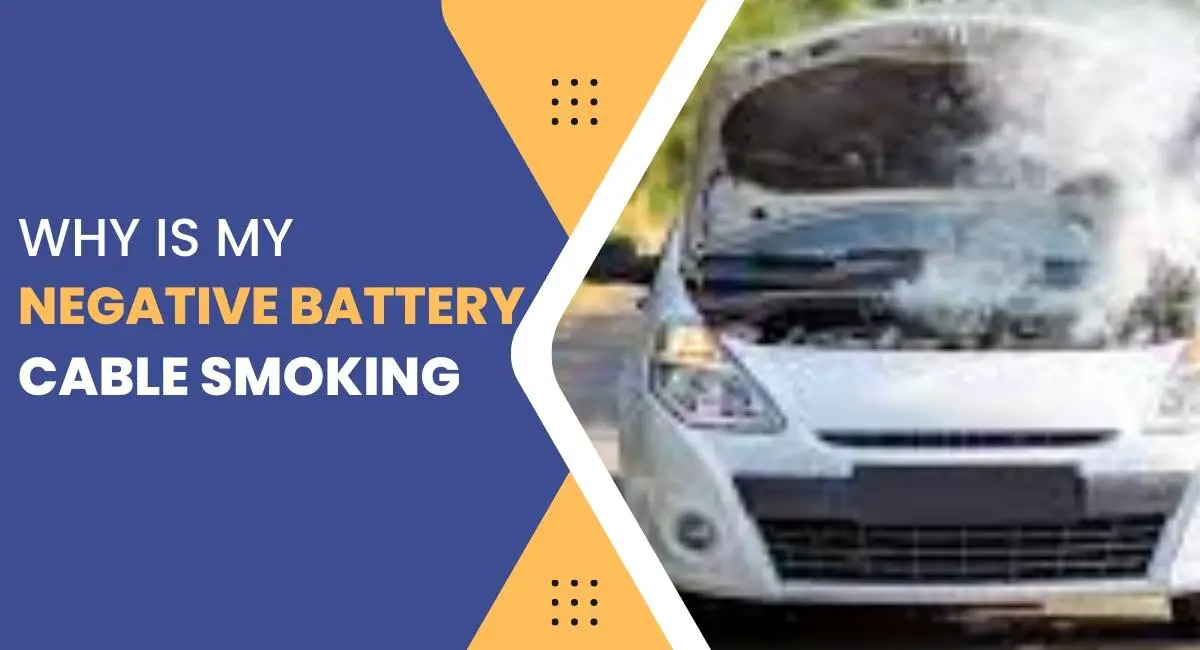Experiencing a smoking negative battery cable can be puzzling and concerning for many car owners. Questions start looming in the mind – why is this happening? What are the reasons behind your negative battery terminal smoking, or why does the entire battery terminal release smoke when trying to start your car?
If the cables exhibit signs of smoke or appear to be melting, this could indicate a poor connection or potential cable damage. Another possibility is that the engine is being cranked for an extended period, causing the cables to overheat. Re-evaluating your cable connections and assessing the state of the cables will help pinpoint the issue, leading to the necessary repairs.
This guide will take you on a comprehensive journey to understand these perplexing situations, including the relatively less common but equally unsettling occurrence of your alternator overheating and releasing smoke.
Understanding the Battery System
Before diving into the specific issues, let’s familiarize ourselves with the fundamentals of a car’s battery system. The system primarily comprises the battery, positive and negative cables, and alternator.
The battery’s job is to store electrical energy, which the car uses when starting and powering certain functions when the engine is off. On the other hand, the alternator replenishes the energy in the battery while the vehicle is running and powers the car’s electrical systems during this time.
The role of the negative battery cable is significant – it often connects the battery to the car’s metal chassis, grounding the electrical system and creating a complete circuit necessary for operation. If there’s a glitch in any of these components, issues like a smoking battery terminal might surface, signifying a serious underlying problem that requires immediate attention.

Why the Negative Battery Cable is Smoking
The occurrence of your negative battery cable emitting smoke is often a clear indication of an underlying issue within your vehicle’s electrical system. Several factors could contribute to this situation, all requiring immediate attention to prevent further complications.
Poor Connectivity
Poor connectivity or corrosion on the negative battery terminal is a possible cause for the negative battery cable emitting smoke. The battery terminals are vital for transferring electrical energy, and any impediments, such as corrosion, can increase electrical resistance. This increase in resistance generates excess heat during the operation, which, in severe cases, can lead to cable smoking. Corrosion is often identifiable as a white, powdery substance on or around the terminal.
Faulty Electrical Components
Another potential culprit behind your negative battery cable smoking is a faulty electrical component in your car that draws excessive current. An unregulated or excessive current draw could lead to overheating the battery cables, causing smoke.
Short Circuits
Moreover, short circuits in your car’s electrical system could also lead to your negative battery cable smoking. A short circuit occurs when electricity takes an unintended ‘shortcut’ around the normal path due to lower resistance. It can cause a sudden surge in electrical current, leading to overheating and the emission of smoke.
Recognizing and addressing these issues promptly is of utmost importance. Leaving them unattended could further damage your battery system and, in extreme cases, even cause a fire. It’s prudent to seek professional help if you suspect an excessive current draw or a short circuit is the problem. Specialists have the right diagnostic tools and expertise to troubleshoot and solve these issues effectively.
Negative Battery Terminal Smoking
When your car’s negative battery terminal starts smoking, it is a telltale sign of a potential problem that needs immediate attention. Three main culprits might make the negative battery terminal smoke – loose connections, corroded terminals, and inadequate cable size for the current passing through.
Loose Connections
A loose connection is one of the most common reasons behind a smoking negative battery terminal. Connecting the battery and its cables is paramount for seamless electrical flow. When this connection is not secure, it can increase the electrical resistance during operation, generating excess heat, resulting in smoke.
Battery Terminal Corrosion
Corrosion on the battery terminal is another typical cause of this issue. Over time, battery terminals can corrode, observable as a powdery white substance on the terminal. Corrosion also increases electrical resistance, leading to overheating and, subsequently, smoking.
Size of
Size of the Negative Battery Cable
The size of the negative battery cable also plays a crucial role in the efficient operation of your car’s electrical system. If the cable is too small to accommodate the current load, it can lead to overheating and smoking. The addition of aftermarket electrical components without upgrading the size of the cables causes this issue.
Warning signs of these issues might include difficulties in starting your car, dimming car lights, or faulty electrical systems., it’s wise to consult a professional mechanic to address these issues. Professionals can accurately diagnose the problem, offer the appropriate solution, and even provide preventive measures to avoid similar issues.
Battery Terminal Smoking When Trying to Start
If you find your battery terminal producing smoke while attempting to start your vehicle, this often indicates an underlying problem that needs prompt addressing.
High Power Draw
The most common reason for this occurrence is the high power draw from the starter motor when you attempt to start your vehicle. The starter motor plays a crucial role in setting the engine into motion, which requires significant electrical power.
If the starter motor is drawing more power than usual – due to a mechanical issue in the engine making it harder to turn over – it causes the battery to work harder. This extra strain, coupled with increased electrical resistance due to poor connections or corroded terminals, can generate enough heat to cause the terminal to smoke.
Drained Battery
Another potential cause is a severely drained or weak battery. If the battery’s charge level is shallow, it can struggle to supply the necessary power to start the car, causing it to overwork and overheat. This overheating could result in smoke emissions from the battery terminal.
It’s vital to ensure that your car battery is always adequately charged and your battery terminals are clean and corrosion-free. If, despite these measures, your battery terminal continues to smoke when trying to start the car, it would be wise to seek professional help. An experienced mechanic can help identify the underlying issue and take necessary corrective actions, ensuring your vehicle’s safety and longevity.
Alternator Getting Hot and Smoking
An alternator getting hot and starting to smoke is a serious concern. This overheating can result from overcharging caused by a faulty regulator, faulty alternator bearings causing excess friction and heat, or blocked or broken vents preventing the alternator from cooling down effectively.
An overheating alternator can, in turn, lead to battery terminal issues because of overcharging. If you notice your alternator getting hot and starting to smoke, it’s crucial to immediately turn off your car and seek professional help. Ignoring this issue can result in further damage and pose a significant fire risk.
Prevention and Maintenance
Prevention and regular maintenance are key to ensuring the health and longevity of your car’s battery system, including the negative battery cables. Here are some essential steps to consider:
Regular Inspections: It’s important to inspect your battery cables and terminals regularly. Look for signs of corrosion, which may appear as a white, powdery substance on the battery terminals. This corrosion can create resistance that results in overheating and, subsequently, smoke. Cleaning the terminals using a wire brush and a mixture of baking soda and water can effectively remove this corrosion.
Secure Connections: Ensure the battery cables have a safe connection to the terminals. Loose connections can increase electrical resistance, causing the cables to overheat. Tighten any loose connections, but be careful not to overtighten them, as this can cause damage to the battery terminal.
Cable Condition: Periodically check the condition of the negative battery cables. Look for signs of wear and tear, fraying, or damage. If the cable’s insulation is damaged or there’s wire fraying, it may be time to replace it.
Battery Health: A regular battery test should be a part of your car’s routine maintenance. A weak or aging battery can cause excessive strain on the battery cables. Most automotive shops can test your battery’s health and tell you when it’s time for a replacement.
Avoid Over-cranking: Try to avoid over-cranking your engine. Over-cranking can cause excessive current flow, leading to overheating cables and smoking.
Appropriate Cable Size: If you add aftermarket electrical components to your vehicle, ensure the battery cables are of the proper size to handle the increased electrical load. Undersized cables may overheat under high current flow.
Professional Maintenance: Lastly, having your vehicle regularly serviced by a professional can help maintain your car’s electrical system health. They can spot potential issues early, helping you avoid problems.
Important Read: Acura MDX Comfort Mode vs Normal Mode Features Explained
By being proactive and taking these preventive measures, you can significantly reduce the chances of encountering issues like a smoking negative battery cable, ensuring your vehicle’s optimal performance and safety.
Conclusion
There can be numerous reasons for the negative battery cable or terminal in your car to smoke, ranging from corroded or loose connections to problems with your alternator. Regular maintenance, coupled with a basic understanding of your car’s battery system, can help you prevent these issues, ensuring the smooth operation of your vehicle. If you notice your negative battery cable smoking, do not ignore it. Prompt action is required to prevent further damage and to ensure your safety on the road. Knowledge and timely action are your best defense against such issues, keeping your car, and by extension, safe on the road.
